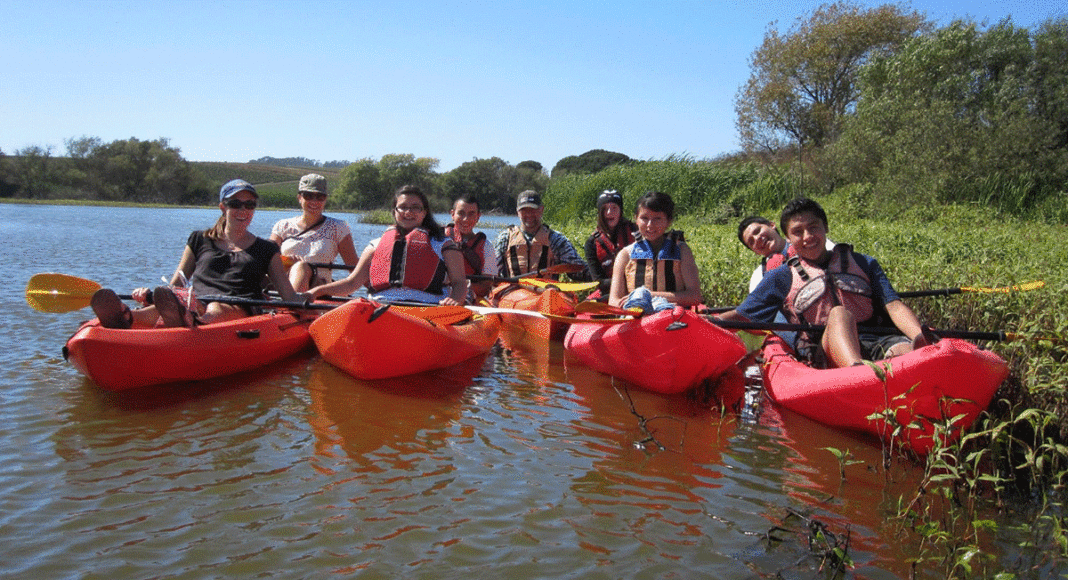The Watsonville wetlands sustain more than 250 species of birds and 23 species of native plants and animals that are threatened or endangered. But they are also serving another unlikely group—more than 300 Pajaro Valley Unified fifth graders.
Last year, the local nonprofit Watsonville Wetlands Watch partnered with the Pajaro Valley Unified School District to create the Wetlands Wonder Program for fifth-grade students. The program aims to increase environmental literacy and stewardship through the “5E” learning model—engage, explore, explain, elaborate and evaluate.
“Watsonville is a fairly urban environment, so getting out to this wild place feels like you are in the middle of nowhere—you wouldn’t know it’s an urban area,” says Emily Howard, Wetlands Watch director of education programs. “Some students have never been to the wetlands before, and they just love it. They discover little animals living in the water. We might see a deer, and they learn about how stewardship is an important part of keeping the wetlands healthy.”
The Watsonville Wetlands Watch is one of 33 local nonprofits selected for the Santa Cruz Gives fundraising campaign. Funds will help support their Wetlands Wonders program alongside many other educational and conservation efforts. All of their programs combined serve more than 3,000 youth in Pajaro Valley. So far, the Watsonville Wetlands Watch is the top fundraiser, and they hope to raise double their initial match of $22,100 in the next few weeks.
The funds raised through Santa Cruz Gives will be used to increase the number of students who participate in the Wetland Wonders program, Watsonville Wetlands Watch director Jonathan Pilch says. The nonprofit hopes to expand the program to new schools in the Pajaro Valley, doubling their current 300 student count.
“We see both a tremendous need and a major opportunity to expand our environmental education programs, with the goal of ensuring that every child in the Pajaro Valley experiences hands-on outdoor learning in a way that inspires them to care about the natural world,” Pilch says, via email. “We’ve seen first-hand how these programs also translate into improved outcomes for their academic and career pathways and inspire youth to take active steps to improve Watsonville’s wetlands, parks, streets, and neighborhoods.”
The Watsonville sloughs are some of the largest freshwater wetlands on the coast. They feature a network of rivers and trails running from the ocean inland to Watsonville, which are often overlooked because waterways aren’t always in plain sight. In 1990, developers proposed building 800 homes on the uplands of Struve Slough, which lies just east of Highway 1. Thanks to a group of concerned citizens that urged the city to protect the wetlands habitat, development was stopped. The group eventually formed into today’s Watsonville Wetlands Watch.
Alongside their Wetland Wonders program, the Watsonville Wetlands Watch facilitates restoration and volunteer opportunities, tours and after school programs. The year-long Wetland Wonders program begins in the classroom, where someone from the Wetlands Watch will talk to the 10- and 11-year-old students about what the wetland ecosystems are and how they operate. This is part of the engage aspect of the 5E model.
Next, the students will explore the Watsonville wetlands in the fall dry season, and collect data on water quality, plants and animals to answer the ultimate question: “How healthy are the wetlands?”
“We don’t want it to be just going out one time for a hike,” Howard says. “Our curriculum is integrated with what they are learning in school and aligned with new content and science standards. We created this program to be more supportive of fifth-grade science standards, while incorporating additional pieces to the classroom.”
The class will return in the spring, once the Wetlands are full, to collect more data and observations. The program ends with a final classroom activity, where students compile the data in bar graphs and come up with suggestions for future wetland protection for the “explain, evaluate and elaborate” components of the 5E educational model.
“The idea is that the students make recommendations to the educators about land management around that slough,” Howard says. “For example, if we noticed that the aquatic invertebrate biodiversity was low when we were there, it could be related to Highway 1 putting runoff into the slough. So maybe they’ll recommend that the highway be moved or that a housing development not go in next to the sloughs.”
Because the students are just being introduced to the habitat ecosystem, Howard says the program doesn’t focus on climate change or the doom and gloom aspects of the environment. Instead, they focus on the smaller tasks that the students can do to help their environment. In some cases, those small tasks, like trash removal, can translate to larger impacts.
“By the end of the second field trip, the students feel a sense of place,” Howard says. “They feel connected to the site, and familiar with it, and they want to do what they can to protect it. That’s a really exciting piece to see.”














